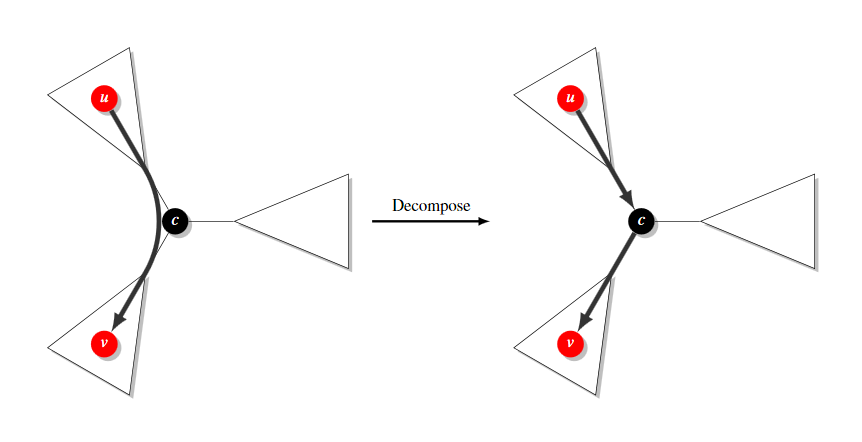CF #458 E. Palindromes in a Tree
重心を求めるコードが間違っていたので修正しました(
sz[v] >= x / 2ではなくsz[v] > x / 2が正しい)。計算量に影響はないです。2018-01-22 21:25http://codeforces.com/contest/914/problem/E
重心分解による分割統治法で解く。重心を c としたとき、回文パスは c を通るものと通らないものに分けることができる。c を通らないものに関しては部分問題で処理することにして、c を通るものに関して処理する。始点が u であるようなパスがいくつあるかが数えられるので、パスu-cにパターン数を加算すると良い。

回文かどうかの判定はビットマスクを使うとやりやすい。
#include <iostream> #include <algorithm> #include <vector> #include <string> #include <map> using namespace std; const int N = 2e5; vector<int> g[N]; bool used[N]; int sz[N]; int a[N]; long long ans[N]; void dfs2(int u, int p) { sz[u] = 1; for (int v : g[u]) if (v != p && !used[v]) { dfs2(v, u); sz[u] += sz[v]; } } int dfs3(int u, int p, int x) { for (int v : g[u]) if (v != p && !used[v]) { // if (sz[v] >= x / 2) { if (sz[v] > x / 2) { return dfs3(v, u, x); } } return u; } long long mp[1 << 20]; void dfs4(int u, int p, int val) { val ^= a[u]; mp[val]++; for (int v : g[u]) if (v != p && !used[v]) { dfs4(v, u, val); } } void dfs5(int u, int p, int val) { val ^= a[u]; mp[val]--; for (int v : g[u]) if (v != p && !used[v]) { dfs5(v, u, val); } } long long dfs6(int u, int p, int val) { val ^= a[u]; long long cnt = mp[val]; for (int i = 0; i < 20; i++) { // (2^i) xor val cnt += mp[(1 << i) ^ val]; } for (int v : g[u]) if (v != p && !used[v]) { cnt += dfs6(v, u, val); } ans[u] += cnt; return cnt; } void dfs(int u) { dfs2(u, -1); u = dfs3(u, -1, sz[u]); dfs4(u, -1, 0); used[u] = true; long long cen = mp[0]; for (int i = 0; i < 20; i++) { cen += mp[1 << i]; } for (int v : g[u]) if (!used[v]) { dfs5(v, u, a[u]); cen += dfs6(v, u, 0); dfs4(v, u, a[u]); } cen /= 2; ans[u] += cen; dfs5(u, -1, 0); for (int v : g[u]) if (!used[v]) { dfs(v); } } int main() { int n; cin >> n; for (int i = 1; i < n; i++) { int u, v; scanf("%d %d", &u, &v); u--; v--; g[u].push_back(v); g[v].push_back(u); } string s; cin >> s; for (int i = 0; i < n; i++) { a[i] = 1 << (s[i] - 'a'); } dfs(0); for (int i = 0; i < n; i++) { printf("%lld ", ans[i] + 1); } }
図のコード。TikZ
% pgfmanual version 3.0.1a \documentclass[dvipdfmx,margin=1cm]{standalone} \usepackage{newtxtext} \usepackage{newtxmath} \usepackage{tikz} \usetikzlibrary{scopes} \usetikzlibrary{calc} % pgfmanual.pdf p.142 \usetikzlibrary{shadows} % pgfmanual.pdf p.689 \usetikzlibrary{shapes.geometric} \begin{document} \begin{tikzpicture}[ foo/.style={fill=black,draw=none,text=white,drop shadow,shape=circle}, bar/.style={fill=white,draw=black,text=white,drop shadow,shape=isosceles triangle}, baz/.style={fill=red,draw=none,text=white,drop shadow,shape=circle}, ] \begin{scope}[local bounding box=scope1] \node [foo] (a) at (0,0) {$c$}; \node [bar,shape border uses incircle,shape border rotate=180,minimum size=2cm] (A) at (0:3) {}; \node [bar,shape border uses incircle,shape border rotate=300,minimum size=2cm] (B) at (120:3) {}; \node [bar,shape border uses incircle,shape border rotate=420,minimum size=2cm] (C) at (240:3) {}; % See pgfmanual.pdf p.703 \draw (a) -- (A.apex); \draw (a) -- (B.apex); \draw (a) -- (C.apex); \node [baz] (u) at (B.center) {$u$}; \node [baz] (v) at (C.center) {$v$}; \draw [-latex,draw=black!80,line width=0.1cm] (u) -- (B.apex) .. controls (120:0.5) and (240:0.5) .. (C.apex) -- (v); \end{scope} \begin{scope}[shift={($(scope1.east)-(scope1.west)+(3.5cm,0)$)},local bounding box=scope2] \node [foo] (a) at (0,0) {$c$}; \node [bar,shape border uses incircle,shape border rotate=180,minimum size=2cm] (A) at (0:3) {}; \node [bar,shape border uses incircle,shape border rotate=300,minimum size=2cm] (B) at (120:3) {}; \node [bar,shape border uses incircle,shape border rotate=420,minimum size=2cm] (C) at (240:3) {}; \draw (a) -- (A.apex); \draw (a) -- (B.apex); \draw (a) -- (C.apex); \node [baz] (u) at (B.center) {$u$}; \node [baz] (v) at (C.center) {$v$}; \draw [-latex,draw=black!80,line width=0.1cm] (u) -- (a); \draw [-latex,draw=black!80,line width=0.1cm] (a) -- (v); \end{scope} % \draw (scope1.south west) rectangle (scope1.north east); % \draw (scope2.south west) rectangle (scope2.north east); % \node [draw,circle] at (scope1.east) {}; % \node [draw,circle] at (scope2.west) {}; \draw [-latex,line width=0.05cm] ($(scope1.east) + (0.5cm,0)$) -- node [auto] {Decompose} ($(scope2.west) + (-0.5cm,0)$); \end{tikzpicture} \end{document}
感想
shape border uses incircle が結構重要っぽくて、これがないと90°単位でしか回転できないらしい。